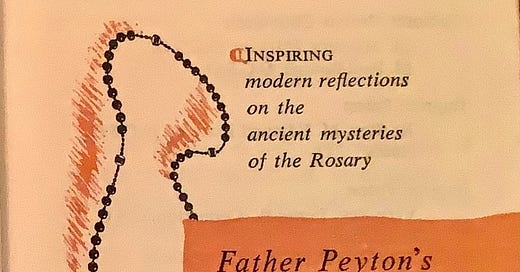Above is the title page of Father Peyton’s Rosary Prayer Book, written “by a Trappist Monk.” While anonymous on the title page, Father Peyton, popularly known as “The Rosary Priest,” identified the author in the Preface of the 1953 edition:
For years I’ve hoped for a book on the Rosary that would be “practical” … but also beautiful. Providence led me to St. Joseph’s Abbey in Spencer, Massachusetts where Dom Edmund Futterer, OCSO is the abbot. Because of the great love for the Family Rosary in that monastery, the abbot assigned the Frater M. Charles, OCSO1 to prepare the meditations.
From his Trappist cell this monk has penetrated into the recesses of heaven, it seems, to capture some of the sublime beauty of Mary, the Mother of God. But he also has been able, in a way that seems to me unequaled, to show the relevance of each mystery to today’s work-a-day world. These thoughts, from the heart of a little known and self-effacing Trappist monk, are both lofty and down-to-earth.
Readers may ask: who was Frater M. Charles, the “little known and self-effacing monk?”
I wondered myself and after corresponding with monks at St. Joseph’s Abbey, am pleased to present a brief summary of Frater Charles’ life of eighty-one years.
Charles Francis Fidler, was born in Boston on November 4, 1925, the son of Charles William and Helen (Fennelly) Fidler; the fifth of sixth children born of the marriage.2
Little is known of his early life but after discerning a religious vocation he first affiliated with the Paulist Fathers briefly before entering the Cistercian monastery of Our Lady of the Valley in Rhode Island on November 1, 1949, three days prior to his twenty-sixth birthday.
Less than five months later, on March 21, 1950 (the transitus3 of St. Benedict), fire destroyed the Rhode Island abbey and the entire community transferred to St. Joseph’s in Spencer, Massachusetts on December 23, 1950.
There, in Spencer, he made his first profession on February 25, 1951, and was ordained a priest on June 7, 1954.
He was brilliant and multi-talented. A member of the high-IQ society Mensa,4 he was, in addition to being an outstanding writer and preacher, much admired for his artwork.
In 1964, Charles “was afflicted with a debilitating illness that made it necessary for him to live outside the monastery. The last years of his life were spent in a dynamic community where he was able to share his gifts with others in a loving atmosphere of mutual support.”5
During his years outside the monastery, he was able to make an occasional brief visit to his beloved abbey. One monk shared with me that when Charles visited, his confreres showed him “great compassion, love and respect. On those rare occasions, catching sight of the enfeebling debilitation of his face and body was to gaze upon an icon of the suffering Christ. And yet, a deeper look into the sparkle of his eyes was a reassurance that he was indeed very pleased to be back at the monastery if only for a fleeting half-hour's stay.”6
From 2004 until his death in 2007 he was able to visit the abbey on Christmas and Easter. It was while he was waiting for his ride to the abbey on Easter Sunday, 2007 that the Lord called him home.7 His funeral Mass was held at the abbey the following Wednesday.
It seems fitting that the soul of this writer who, in Father Peyton’s words, “penetrated into the recesses of heaven,” and who was seen by his confreres as “an icon of the suffering Christ,” would leave this earth for its heavenly home on Easter Sunday.
Requiescat in pace, Frater Charles.
Order of Cistercians of the Strict Observance, originally named the Order of Reformed Cistercians of Our Lady of La Trappe.
FamilySearch.org.
“Transitus” in Latin means passing from one state to the next—death is not the end of life, but the transition into eternity with God.
Per correspondence with the abbey.
Obituary, published in the Worcester, Massachusetts Telegram, April 10, 2007.
Per correspondence with the abbey.
Obituary.




